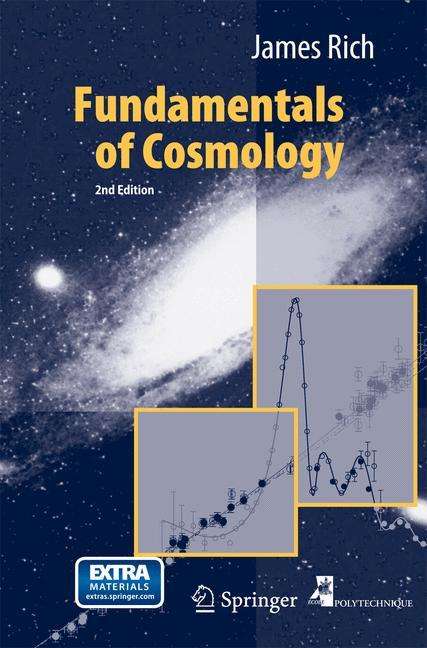James Rich: Fundamentals of Cosmology
Fundamentals of Cosmology
Buch
lieferbar innerhalb 2-3 Wochen
(soweit verfügbar beim Lieferanten)
(soweit verfügbar beim Lieferanten)
-23%
EUR 69,78**
EUR 53,32*
- Springer Berlin Heidelberg, 11/2014
- Einband: Kartoniert / Broschiert, Paperback
- Sprache: Englisch
- ISBN-13: 9783642425745
- Bestellnummer: 6812689
- Umfang: 340 Seiten
- Sonstiges: 16 Tabellen,
- Nummer der Auflage: 14002
- Auflage: 2nd ed. 2010
- Copyright-Jahr: 2014
- Gewicht: 506 g
- Maße: 236 x 154 mm
- Stärke: 22 mm
- Erscheinungstermin: 11.11.2014
Achtung: Artikel ist nicht in deutscher Sprache!
Kurzbeschreibung
This book provides an introduction to general relativity based on the homogeneity and isotropy of the local universe. It aims to help the reader to understand the basics of cosmology and general relativity. All relevant experiments are explained and reported.Beschreibung
A self-contained introduction to general relativity that is based on the homogeneity and isotropy of the local universe. Emphasis is placed on estimations of the densities of matter and vacuum energy, and on investigations of the primordial density fluctuations and the nature of dark matter.Inhaltsangabe
Observational Cosmology.- Coordinates and Metrics.- The Field Equations.- Friedmannology.- The Thermal History of the Universe.- Structure Formation.Rezension
From the reviews:"The book provides a comprehensive and thorough explication of current cosmology at a level appropriate for a beginning graduate student or an advanced and motivated undergraduate. It covers all relevant concepts of cosmology and pertinent general relativity and contains a significant number of exercises, with solutions to a sample set. This book clearly is the result of the refining of notes from a course on cosmology It provides a summary of current observations and mathematical underpinnings of the physical principles. This is an extremely valuable contribution in the field, which has been changing rapidly as a result of new technology and new theoretical motivations from the related field of high-energy physics This book provides a good look at the intellectual effort and a solid foundation for the new discoveries soon to come." (Physics Today, September 2002)
"All these exciting developments are laid out in a very accessible form in this textbook especially written for senior undergraduates or graduates from various backgrounds. It deals in a very nice and explicit form with the basic ideas of cosmology and general relativity (...). This is a fine textbook and would be very enjoyable for private study. (The Physicist, 2001)
From the reviews of the second edition:
Rich, a cosmologist at CEA, a French technological research organization, provides a systematic exposition of modern cosmological models and observations, written in a clear, engaging style that does not assume prior knowledge of the subject. It would make an excellent advanced undergraduate or first-year graduate textbook, or a good reference for anyone wanting a clear introduction to the ideas of modern cosmology. Summing Up: Highly recommended. Upper-division undergraduates, graduate students, and researchers / faculty in the physical sciences; professionals / practitioners. (R. L. Mutel, Choice, Vol. 47 (11), August, 2010)
Klappentext
Thisisthesecondeditionofabookonthephenomenological foundations ofmodern cosmology. The ?rst edition was surprisingly well timed. In the preceding 3 years, advances in astronomy had laid the foundations of the dark-energy / dark-matter c- mological model. In 1998, observations of type Ia supernova by the Supernova C- mology Project and High Z team suggested that the expansion of the universe is accelerating. In 2000, Boomerang and Maxima observed clearly the ?rst acoustic peak in the anisotropy spectrum of the cosmic microwave background. The position of the peak strongly suggested that the density of the universe was near critical. These two observations reconciled popular in?ationary models with the heretofore embarrassing insistence by astronomers that the clumping of galaxies required that the mass density of the universe be only about 25% of the critical density. The sup- nova data told us that the rest was dark energy in the form of an effective vacuum energy or cosmological constant. The so-called LambdaCDM model became the standard model. Eight years later, the observational data has improved tremendously as a c- parison of the ?gures in the two editions will demonstrate. Surprisingly, all this incredible data has failed to ?nd any clear failure of the?CDM model. Among the observational advances, the most obvious comes from the WMAP satellitewho, alongtheground-basedexperimentslikeACBAR, yieldedtheexquisite series of peaks in the CMB temperature anisotropy spectrum shown in Fig. 7.11.
James Rich
Fundamentals of Cosmology
EUR 69,78**
EUR 53,32*

